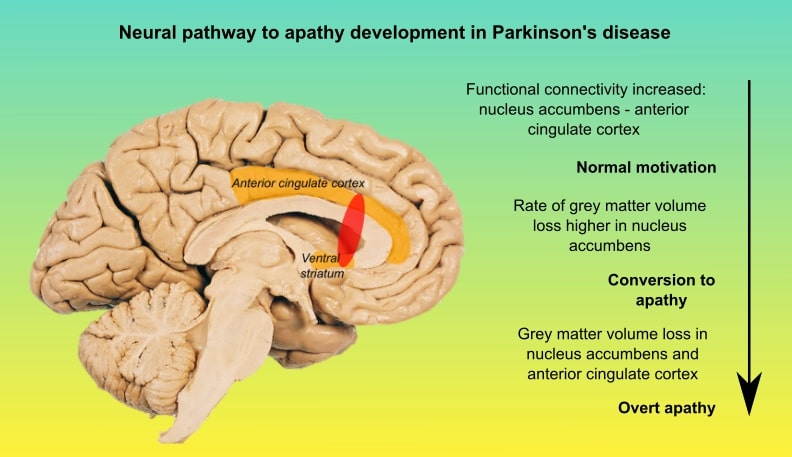Category: Parkinson's Disease: Neuroimaging
Objective: To investigate whether changes in connectivity between neural regions that are associated with goal-directed behaviour predict future development of apathy in people with Parkinson’s disease.
Background: Work in animal and human neuroscience has identified neural regions associated with the production of motivated, goal-directed behaviour. In particular, the nucleus accumbens and anterior cingulate cortex are recognized as key network nodes underlying decisions of whether to exert effort for reward to drive behaviour towards goals. Previous work has convincingly shown that this cognitive mechanism, known as effort-based decision making, is altered in people with Parkinson’s disease with apathy. We hypothesised that changes in these regions would precede the development of apathy in people with Parkinson’s disease.
Method: We performed a large, multimodal neuroimaging analysis in a cohort of people with Parkinson’s disease (n = 199) with and without apathy at baseline. All participants had ~ 2 year follow-up apathy scores, enabling examination of brain structure and function specifically in those with normal motivation who converted to apathy by ~ 2 year follow-up. In addition, of the people with normal motivation, a subset (n = 56) had follow-up neuroimaging data, allowing for examination of the rate of change in key nodes over time in those who did, and did not, convert to apathy.
Results: At baseline, functional connectivity between the nucleus accumbens and anterior cingulate cortex was higher in people with normal motivation who later converted to apathy compared to those who did not, but no structural differences were evident. In contrast, baseline grey matter volume in these regions was reduced in the group who were already apathetic. Furthermore, in those with normal motivation at baseline, converters to apathy showed a higher rate of change (reduction) in grey matter volume within the nucleus accumbens (p = 0.03) compared to those who remained non-apathetic.
Conclusion: Changes in functional connectivity between nucleus accumbens and anterior cingulate cortex precedes apathy in people with Parkinson’s disease, with evolving structural change accompanying overt apathy. This pattern of results provides a plausible causal pathway to loss of motivation in Parkinson’s disease.
To cite this abstract in AMA style:
L. Morris, S. Harrison, T. Melzer, J. Dalrymple-Alford, T. Anderson, M. Macaskill, C. Le Heron. Altered nucleus accumbens functional connectivity precedes apathy in Parkinson’s disease [abstract]. Mov Disord. 2023; 38 (suppl 1). https://www.mdsabstracts.org/abstract/altered-nucleus-accumbens-functional-connectivity-precedes-apathy-in-parkinsons-disease/. Accessed January 1, 2026.« Back to 2023 International Congress
MDS Abstracts - https://www.mdsabstracts.org/abstract/altered-nucleus-accumbens-functional-connectivity-precedes-apathy-in-parkinsons-disease/

